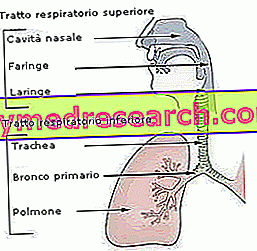The bronchi represent the airways contiguous to the trachea, which - in the adult - bifurcates at the level of the 4th-5th thoracic vertebra to give rise to the two primary or primary bronchi, one for the right lung and one for the left lung. The primary bronchi are subdivided in turn into branches of ever smaller caliber, constituting the so-called bronchial tree (just like a plant, they form branches that progressively diminish in size).

Like the upper airways (nasal cavities, nasopharynx, pharynx, larynx and trachea), the bronchi are essentially responsible for transporting air from the external environment to the functional units of the lungs, the alveoli, in which gas exchange takes place (the pulmonary alveoli are small pockets filled with air, densely surrounded by capillaries and deputed to the exchange of oxygen and carbon dioxide).
The structure of the primary bronchi is identical to that of the trachea; as such, they maintain a cartilaginous support structure in their wall. Branching gradually into smaller caliber ducts, the bronchi give rise to the so-called bronchioles, in which the cartilaginous structure described above is lost.

After penetrating into the relevant pulmonary lobes, each lobar or secondary bronchus divides into the various bronchopulmonary segments. Inside the lungs, the lobar bronchi lose the cartilaginous support structure typical of the trachea and primary bronchi (C-rings), covering themselves with irregular plaques of hyaline cartilage, while the smooth muscle forms complete rings (unlike what happens in the trachea, where the posterior cartilaginous openings are filled by the tracheal muscle). In this way the intrapolmonary bronchi no longer have a flattened portion posteriorly, but are completely rounded.

As one enters the bronchial tree, the thickness of the bronchial walls, less and less rich in cartilaginous tissue and increasingly rich in muscle tissue, is also reduced along with the airway gauge.
As soon as they enter the lung lobes, the secondary bronchi are subdivided into smaller branches, the so-called tertiary (or segmental) bronchi . Each of these branches out by serving with distinct branches of the lung tissue, called bronchopulmonary segments. As shown in the figure, each lung is in fact divided by 10 bronchopulmonary segments, separated from each other by connective tissue.
The so-called bronchioles originate from the tertiary bronchi, through repeated ramifications. As anticipated, as the bronchial airways become thinner, the amount of cartilage in their wall also decreases; at the same time, the number of glands and goblet cells (important for preventing the entry of germs and dust) decreases, while the contribution of smooth muscle tissue and elastic tissue increases. Furthermore, the height of the epithelium progressively decreases, while in terminal bronchioles the hair cells become cuboidal (from columnar or cylindrical), losing their eyelashes and flattening further in the areas assigned to gas exchange (where muscle tissue is absent).
| Subdivision of the bronchial tree | ||
| FIRST NAME | NUMBER | DIAMETER (cm) |
| Main bronchi (primary) | 2 | About 1.3 |
| Bronchi lobari (secondary) | 5 | About 0.9 |
| Segmental or zonal bronchi (tertiary) | 10 | About 0.7 |
| Subsegmental bronchi | About 20 | About 0.5 |
| bronchioles | About 78, 000 | About 0.05 to 0.018 |
| Respiratory bronchioles | 900, 000 approximately | About 0.015-0.011 |
| Honeycomb sacks | About 7, 000, 000 | About 0.010 |
| Alveoli | About 300, 000, 000 | About 0.005 |
In turn, the bronchioles are subdivided repeatedly giving rise to smaller and smaller ducts, the so-called terminal bronchioles, with a diameter of less than 0.5 mm. These constitute the terminal part of the system of conduction of the respiratory apparatus; in fact they supply air to the pulmonary berries where gas exchange takes place.

The bronchioles have neither glands nor cartilage in their wall, while they have a continuous layer of smooth muscle that provides support to the mucosa; they also contain the so-called Clara cells, which replace the muciparous goblet cells and are presumably used to protect the respiratory epithelium from bacteria, toxins and from collapse, also providing for its regeneration in case of damage.
Below, the terminal bronchioles continue with the respiratory bronchioles, which differ considerably from the progenitors in that they are provided with alveoli that open directly on their wall; they therefore have a dual function, both of conduction and of gas exchange.



